This page describes how to determine wind direction and relative wind speed using two common types of weather maps, 500 mb height maps, which we have already studied, and surface weather maps, which show a contour pattern of sea level air pressure. The reason to go over this material now is that we are going to cover hurricanes beginning next week and the winds both at the surface and at 500 mb are important in understanding hurricane strength and damage potential as well as the overall storm movement.
Based on my past experience, students can miss the basic points about wind and weather maps when too much physical and scientific detail is provided about winds, such as describing all the forces that act on the air to determine wind direction and speed. Since this is not just a weather class and you do not have to understand all the details for other course topics, only a basic description of winds and weather maps is provided.
In describing weather, wind is generally taken to mean the horizontal movement of air. By convention, the wind direction is the direction from which the wind is blowing (e.g., a north wind means the air is moving from north toward south) and the windspeed is the speed at which the air is moving relative to the ground. Surface winds blow along the surface of the Earth where we live. But there are also winds blowing along horizontal paths at altitudes above the ground surface, for instance, the 500 mb winds that have been previously discussed. The horizontal winds often change considerably at different altitudes.
After studying this page, ATMO 336 students are expected to:
Weather maps show the pattern of air pressure on horizontal surfaces. Using this information we can visually determine the approximate wind pattern. For example, we previously described how to determine the 500 mb winds based on 500 mb height maps.
On this page, we will discuss how to determine the wind pattern at the ground surface based on surface weather maps that show the pattern of sea level air pressure. We are not going to discuss the physical forces that cause winds in much detail. The main point is how to interpret the surface wind pattern based on the contour pattern depicted on surface weather maps. The surface wind pattern will be described by comparing it with how the 500 mb wind pattern is determined from the contours of 500 mb height. The reason for including this page now is that we are going to cover hurricanes next, and you will be expected to understand what hurricanes look like on surface weather maps in terms of the pattern of sea level pressure, basically why the winds are strong around hurricanes, and that the wind pattern causes air to move vertically upward, which is essential in the formation of clouds and heavy rain .
First let's add a little more explanation for the interpretation of 500 mb wind speed based on the 500 mb height pattern, which was discussed on a prevous reading page. Horizontal winds are caused by horizontal changes in air pressure. The more quickly air pressure changes along a horizontal direction, the faster the winds. Although 500 mb maps show a pattern of height changes, the height pattern also indicate how rapidly the air pressure is changing at the altitude where the air pressure is 500 mb. Thus, closely spaced 500 mb height contours represent regions where the air pressure is changing rapidly along a horizontal direction. In meteorology, the rate at which air pressure changes along a horizontal direction is defined as the pressure gradient. Recall from a previous reading page that 500 mb winds were said to be stronger where the height contours are closely packed together and weaker where the 500 mb height lines are spread far apart. The reason behind this is that the pressure gradient, which is the root cause of all wind, is larger where the height lines are tightly packed together. The same principle can be applied to interpretation of wind speeds based on surface weather maps, which show the contoured pattern of sea level air pressure.
On surface weather maps, the contour lines are lines of equal sea level pressure, called isobars, rather than the height of an equal pressure surface, such as the 500 mb height on 500 mb maps. The average sea level air pressure is 1013.25 mb (roughly 1000 mb), but it varies with both time and location. A surface weather map shows a snapshot of the sea level air pressure pattern valid at the time indicated with the map label. The contoured pattern of sea level pressure is used to estimate surface winds. It is similar, but not exactly the same, as how 500 mb height contours are used to estimate 500 mb winds.
![[pgf]](sfcpress_example_annotated.png) |
Shown on the left is a surface weather map with isobars. The labeled contours in green represent the pattern of sea level air pressure. The contour values on the lines are a little hard to read. The large 'L' represents the center of a closed low with a pressure of 985 mb. Starting with the innermost circular green contour (or moving away from the low center), the contour values are 988 mb, 992 mb, 996 mb, 1000 mb, and 1004 mb. Two regions are circled on the map. The yellow circle highlights an area with a large pressure gradient, which is indicated by the tight spacing of the contour lines. Strong surface winds are expected in this area due to the large pressure gradient. The blue circle highlights an area with a much smaller pressure gradient, which is indicated by the large spacing between the contour lines. Weaker surface winds are expected in this area due to the smaller pressure gradient. We are not going to cover the "pressure gradient" in any detail. A pressure gradient is the change in pressure divided by the distance over which the change happens. All winds arise due to pressure gradients or the changes in pressure along a horizontal surface. The stronger the pressure gradient, i.e., the faster that pressure changes along a horizontal surface, the stronger the winds. On a weather map, strong pressure gradients are present where the contour lines are closely packed together because this indicates regions where the pressure changes rapidly with distance. In these regions, we expect strong winds. Conversely, weak pressure gradients are present where the contour lines are spread far apart because this indicates regions where the pressure is changing slowly with distance. In these regions, we expect weak winds. An important concept for this class is to be able to identify where winds are stronger and where winds are weaker based on the contour pattern shown on weather maps.
We will not routinely look at surface maps in this class. I want you to know what strong surface storms and hurricanes look like on surface weather maps. Strong surface storms typically show up as closed lows with a tight packing of the isobars (contour lines) around the center of the low. The low pressure system centered over the state of Nebraska on the map is an example of a strong surface storm. Examples of hurricanes are shown below.
The surface wind direction relative to the pattern of isobars is generally the same as it is for 500 mb wind direction and height contours, i.e., the surface wind direction is mostly parallel to the isobars with lower pressure to the left of the wind direction, but there is one very important difference: the surface wind is not fully parallel to the isobars, and the surface wind slightly crosses the isobars toward lower pressure. The average angle between the surface winds and the isobars is about 30°. When I look at a surface map with isobars, I start by visualizing the winds pattern as parallel to the contours, then shift this pattern to point slightly toward lower pressure.
The figure below shows the wind direction for straight line contours of 500 mb height, like what you may see on a 500 mb map, on the left side and sea level pressure (isobars), like what you may see on a surface weather map on the right side. As described in previous reading material, the 500 mb winds blow parallel to the height contours (along the contour lines without crossing them) with lower heights to the left of the wind direction. For surface winds, the wind direction is nearly the same, however, it is not fully parallel to the contours. The surface wind moves slightly toward lower pressure such that the wind direction crosses the isobars at an average angle of about 30°.
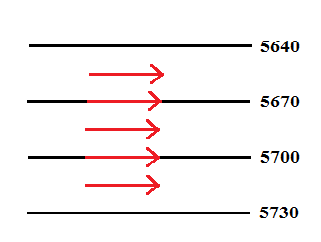 Portion of a 500 mb height map with straight line contours. The black lines are contours of 500 mb height.
Red arrows show the direction of the 500 mb wind, which is parallel to the height contours with lower heights to the left of the wind direction.
Portion of a 500 mb height map with straight line contours. The black lines are contours of 500 mb height.
Red arrows show the direction of the 500 mb wind, which is parallel to the height contours with lower heights to the left of the wind direction.
|
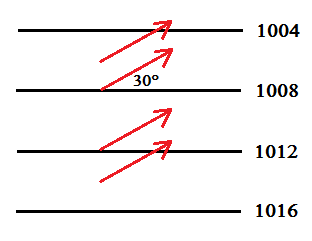 Portion of a surface weather map with straight line contours. The black lines are isobars or contours of sea level pressure.
Red arrows show the direction of the surface wind, which crosses the isobars at an angle of 30° toward lower pressure.
Portion of a surface weather map with straight line contours. The black lines are isobars or contours of sea level pressure.
Red arrows show the direction of the surface wind, which crosses the isobars at an angle of 30° toward lower pressure.
|
The wind trajectories around closed lows in the contour pattern are shown below. The wind trajectory represents the path followed by air moving along with the flow. At the 500 mb height level, the winds are counterclockwise around the center of the low, and move in a circle around a circular closed low. Again this is parallel to the contours with lower contour values to the left of the wind direction. The surface wind pattern around a closed low is counterclockwise as well, but also crosses the contour lines toward lower pressure. Thus, the surface wind around closed lows moves counterclockwise and spirals in toward the center of the low. The wind directions relative to the pattern of height contours on 500 mb maps and isobars (sea level pressure contours) on surface maps is for the Northern Hemisphere of the Earth. To avoid confusion, we are only going to worry about the Northern Hemisphere in this class.
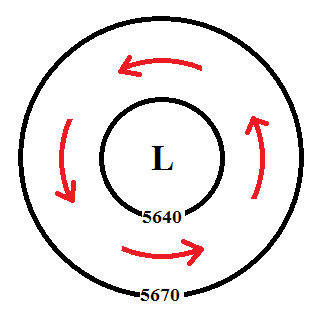 Portion of a 500 mb map with a closed low. The black lines are contours of 500 mb height. Red arrows show the wind
trajectory or air flow pattern. The air flow is parallel to the height contours and counterclockwise around the center of the closed low.
Portion of a 500 mb map with a closed low. The black lines are contours of 500 mb height. Red arrows show the wind
trajectory or air flow pattern. The air flow is parallel to the height contours and counterclockwise around the center of the closed low.
|
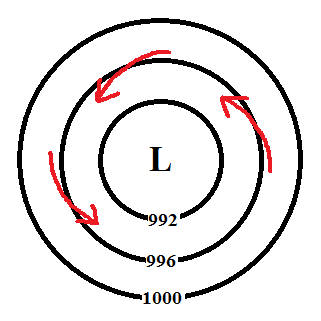 Portion of a surface map with a closed low. The black lines are isobars or contours of sea level pressure. Red arrows show the wind
trajectory or air flow pattern. The flow is counterclockwise and converging toward the center of the closed low.
Portion of a surface map with a closed low. The black lines are isobars or contours of sea level pressure. Red arrows show the wind
trajectory or air flow pattern. The flow is counterclockwise and converging toward the center of the closed low.
|
On surface weather maps, the center of a hurricane has very low pressure. There are closely spaced (or tightly packed) isobars around the center of the storm. Two examples are shown below.
 |
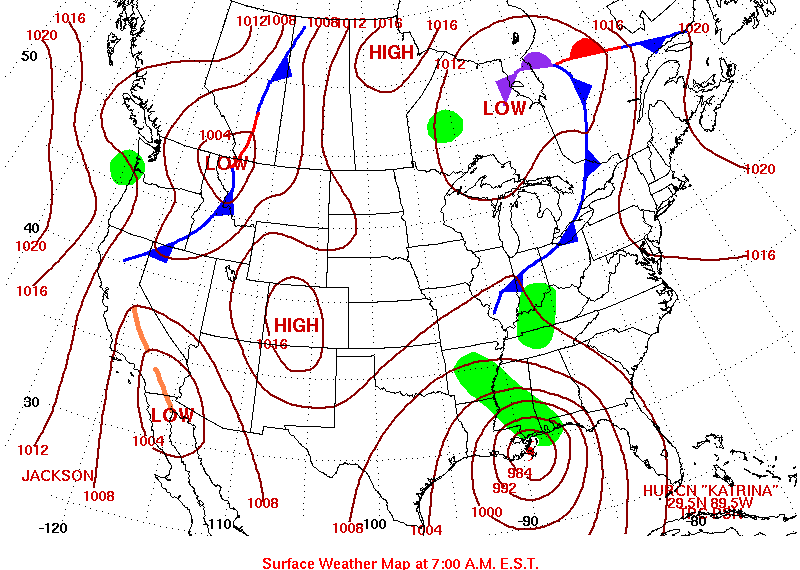 |
| Hurricane Sandy in 2012 | Hurricane Katrina in 2005 |
The fact that surface winds blow slightly toward low pressure (and slightly away from high pressure) is important in understanding why surface low pressure areas are associated with clouds and precipitation and why surface high pressure areas are associated with fair weather. This is discussed in the next section.
An important consequence of the fact that winds just above the ground surface do not blow parallel to the isobars, but slightly toward low pressure (and away from high pressure), is that sea level pressure pattern and winds can force air to move upward or downward. This is important because upward moving air is associated with cloud formation and precipiation, while downward moving air is assoicated with fair weather and a lack of clouds. First a couple of definitions. The wind pattern is said to be convergent in regions where there is a horizontal inflow of air toward the region and divergent in regions where there is a horizontal outflow of air away from a region. The pattern of the arrows in the figures below show examples examples of purely convergent and divergent air flow.

Instructive images for horizonal convergence of air. Arrows show horizontal wind pattern. Left side shows pure covergence toward a line, while right side shows pure convergence toward a point. In realistic surface air flow, the wind pattern is just slightly convergent toward lines or points of low pressure. |
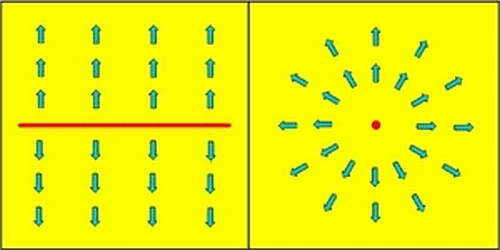
Instructive images for horizonal divergence of air. Arrows show horizontal wind pattern. Left side shows pure divergence away from a line, while right side shows pure divergence away from a point. In realistic surface air flow, the wind pattern is just slightly divergent away from lines or points of high pressure. |
Of importance for weather, when the horizontal air flow at the surface is convergent (flowing together), air is forced to rise (move vertically upward). Conversely, when the horizontal air flow at the surface is divergent (flowing away), air is forced to sink (move vertically downward). To help you understand this relationship, think of air as a fluid that flows, just as water or even a tube of toothpaste. Squeezing a tube of toothpaste from the bottom is horizonal convergence. Toothpaste is forced upward by the convergence, just like air will be forced upward when there is horizontal convergence of air at ground level. In other words, squeezing air together near the ground forces some air to rise upward, since it cannot go down into the ground. Conversely, if you could pull apart a tube of toothpaste from the bottom, then paste from above will move down to fill the space. In other words, when air is flowing out of a region at the surface of the earth (divergence), air will sink down from above to fill the space.
Since the winds at the surface flow toward lower pressure and away from higher pressure, surface low pressure areas are associated with surface convergence, forced rising air, and a good possibility for clouds and precipitation, while surface high pressure areas are assoicated with surface divergence, forced sinking air, and generally fair, cloud-free weather. The figure below also shows that rising and sinking air can be forced by convergence and divergence from the top of the troposphere as well. Later in the semester, we will learn that upper level divergence happens just downstream of 500 mb troughs and this forces rising air motion along with the possibility of clouds and rain, while upper level convergence happens just downstream of 500 mb ridges and this forces sinking air motion with fair weather expected. Following are two links that review this information, which you may find useful. One is a WORD document about winds and weather maps which includes figures and the other is an image document showing horizontal convergence, divergence, and vertical motion.
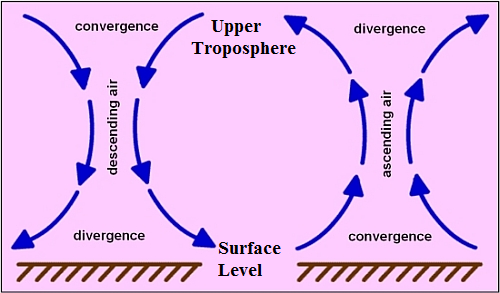 Relationship between horizontal covergence and divergence and vertical air motion.
Relationship between horizontal covergence and divergence and vertical air motion. -- Left side shows that sinking air motion (downward moving air) is forced by horizontal covergence at the top of the troposphere and divergence at the surface or bottom of the troposphere. Convergence in the upper troposphere happens just downwind of 500 mb ridges. Divergence in the lower troposphere takes place near surface high pressure areas. -- Right side shows that rising air motion (upward moving air) is forced by divergence at the top of the troposphere and convergence at the surface or bottom of the troposphere. Divergence in the upper troposphere happens just downwind of 500 mb troughs. Convergence in the lower troposphere takes place near surface low pressure areas. Clouds and precipitation form in regions where air is ascending or moving upward. |
Look again at the surface map for April 8 shown above on this page. You should now realize that the winds near the surface low over Nebraska will be counterclockwise and inward (converging), which forces air to rise upward. The winds will also be relatively strong due to the strong pressure gradient force (tight packing of the isobars). In fact, weather systems that produce both strong surface winds and significant precipitation will have surface low pressure at their center. The tight pressure gradient results in strong winds and the convergence and forced rising motion produces clouds and precipitation. The strongest of these low pressure systems are the epic storms of history. These include winter storms as well as hurricanes. The surface map for 18Z on Thursday, January 4, 2018, which has an example of a strong winter storm just off the northeastern coast of the United States, is shown below.
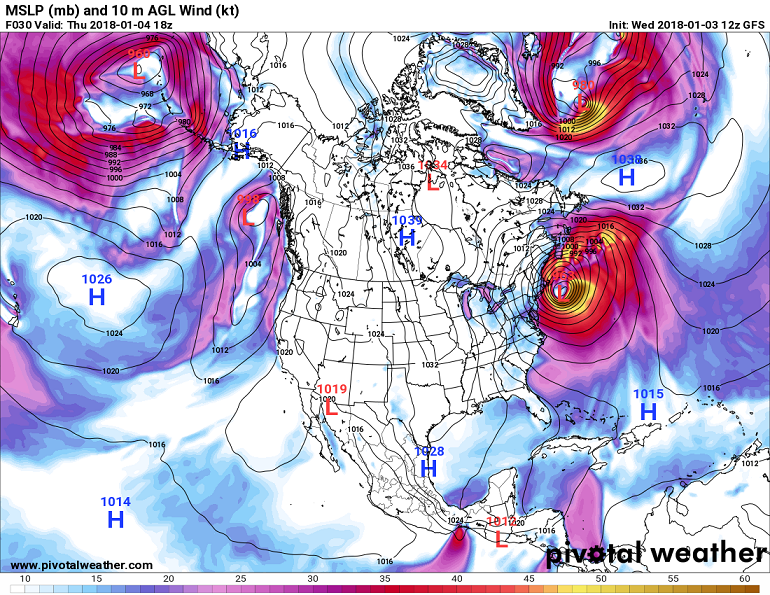 Surface map from 18Z on Thursday, January 4, 2018. The labeled contours are isobars or lines or equal sea level pressure.
Notice the strong surface low pressure (963 mb at center) just off the northeast coast of the United States, which
indicates a strong winter storm. The color shading represents the surface wind speed in nautical miles per hour (knots).
The strongest winds are found where the isobars are closely packed together. Note that winds are stronger over the
oceans and Great Lakes relative to land areas, even when the isobar spacing is the same. This is because there is less
frictional drag over the smooth water surface relative to the rougher land surface, which results in slower wind speeds
over land for the same pressure gradient.
Surface map from 18Z on Thursday, January 4, 2018. The labeled contours are isobars or lines or equal sea level pressure.
Notice the strong surface low pressure (963 mb at center) just off the northeast coast of the United States, which
indicates a strong winter storm. The color shading represents the surface wind speed in nautical miles per hour (knots).
The strongest winds are found where the isobars are closely packed together. Note that winds are stronger over the
oceans and Great Lakes relative to land areas, even when the isobar spacing is the same. This is because there is less
frictional drag over the smooth water surface relative to the rougher land surface, which results in slower wind speeds
over land for the same pressure gradient.
|